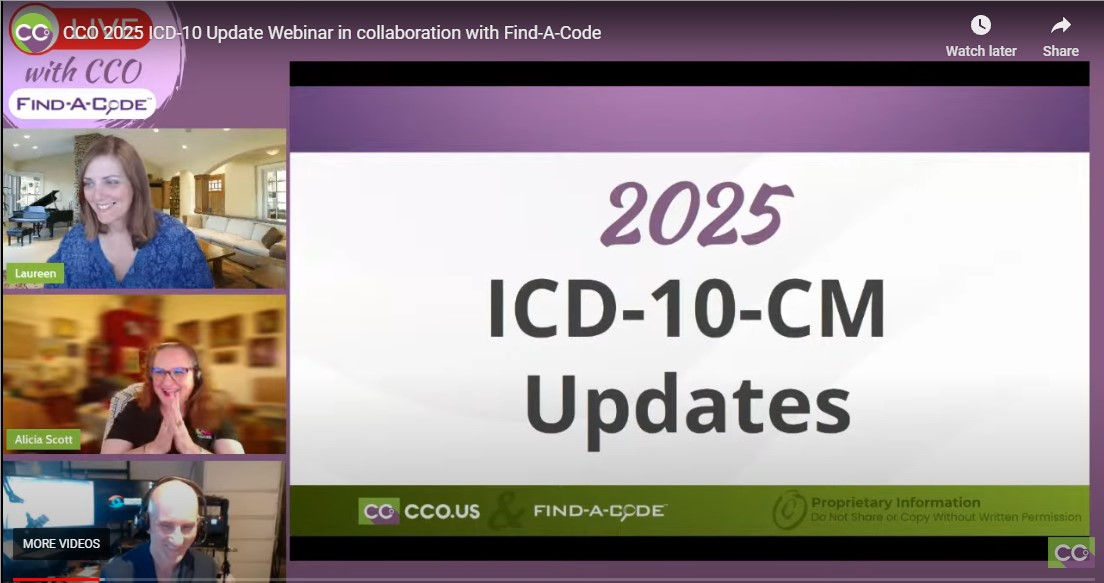by Brittney Murdock, QCC CMCS CPC
Jun 27th, 2016
The final version of the 2017 ICD-10- PCS codes has been released by the Center for Medicare and Medicaid Services. Beginning on October 1, 2016, the first day of the federal fiscal year, the use of these codes will become mandatory for hospital inpatient services.
The updates for the 2017 ICD-10- PCS codes include 3,827 new codes, 491 revised [titles] codes and 12 deleted codes. In all, there will be 75,789 codes for FY2017 compared to 71,974 codes for FY2016.
Some of the other changes include the revision of root operation definitions Control and Creation in the Medical and Surgical section, the addition of the root operation Perfusion in the Extracorporeal Therapies and the revision of the ICD-10- PCS Official Coding Guidelines in response to public comment and internal review.
ICD-10- PCS Definition Updates
For the definition of the root operation ‘Control’, the previous Definition and Includes/Examples were:
- Definition: Stopping, or attempting to stop, postprocedural bleeding
- Includes/Examples: Control of post-prostatectomy hemorrhage, control of post-tonsillectomy hemorrhage
The new Definition and Includes/Examples for 2017 are:
- Definition: Stopping, or attempting to stop, postprocedural or other acute bleeding
- Includes/Examples: Control of post-prostatectomy hemorrhage, control of intracranial subdural hemorrhage, control of bleeding duodenal ulcer, control of retroperitoneal hemorrhage
The definition of the new root operation ‘Perfusion’ is:
- Definition: Extracorporeal treatment by diffusion of therapeutic fluid
ICD-10- PCS Code Updates
A majority of the additions, revisions and deletions are in the Cardiovascular specialty. Some examples of these updates include the following:
Aortic Artery
The addition of specific anatomical sites to the aortic artery, which include:
- Aortic arch
- Ascending aorta
- Descending aorta
Artery Bypass
For artery bypasses, pulmonary artery codes have been added:
- Left Pulmonary Artery: 021R
- Right Pulmonary Artery: 021Q
- Pulmonary Trunk: 021P
Also added are codes for pulmonary vein bypasses:
- 021V0KS Bypass Superior Vena Cava to Right Pulmonary Vein with Nonautologous Tissue Substitute, Open Approach
- 021V0KT Bypass Superior Vena Cava to Left Pulmonary Vein with Nonautologous Tissue Substitute, Open Approach
- 021V0KU Bypass Superior Vena Cava to Pulmonary Vein Confluence with Nonautologous Tissue Substitute, Open Approach
Also, the code description for coronary artery bypasses has been revised to read ‘arteries’ instead of ‘sites’.
- Previous code: Four or More Sites: 0213
- Revised code: Four or More Arteries: 0213
Measurement and Monitoring
Indocyanine green (ICG) is a cyanine dye used in medical diagnostics. It is used for determining cardiac output, hepatic function and liver blood flow, and ophthalmic angiography In the Measurement and Monitoring section, indocyanine green dye has been added as a 7th character qualifier.
Example:
- 4A1BXSH Monitoring of Gastrointestinal Vascular Perfusion using Indocyanine Green Dye, External Approach
Perfusion
New codes have been added for perfusion. These codes are for donor organs in which fluid is pumped through them to preserve the organ.
Examples:
- 6AB50BZ Perfusion of Circulatory Donor Organ, Single
- 6ABB0BZ Perfusion of Respiratory System Donor Organ, Single
- 6ABF0BZ Perfusion of Hepatobiliary System and Pancreas Donor Organ, Single
- 6ABT0BZ Perfusion of Urinary System Donor Organ, Single
New Technology Codes
Spinal Fusions
For spinal fusions, codes have been added for nanotextured surface interbody fusion devices. These devices have an increased amount of nano-scaled textures to a currently-available device to create a statistically significant greater amount of the osteogenic and angiogenic growth factors that are critical for bone growth and fusion.
Examples:
One vertebra:
- XRG1092 Fusion of Cervical Vertebral Joint using Nanotextured Surface Interbody Fusion Device, Open Approach, New Technology, Group 2
Two or more vertebra:
- XRG2092 Fusion of 2 or more Cervical Vertebral Joints using Nanotextured Surface Interbody Fusion Device, Open Approach, New Technology Group 2
Growth Rods
Magnetically-controlled growth rods have been added as a 6th character Device/Substance/New/Technology. a non-invasive treatment for children with early onset scoliosis. After the initial procedure to implant the rod, doctors use an external remote control outside of the body to lengthen the magnetically controlled rod as a child grows.
Examples:
- XNS3032 Reposition of Cervical Vertebra using Magnetically Controlled Growth Rod(s), Open Approach, New Technology Group 2
- XNS3432 Reposition of Cervical Vertebra using Magnetically Controlled Growth Rod(s), Percutaneous Endoscopic Approach, New Technology Group 2
Uridine Triacitate
Urinadine triacetate, also known under the Brand name Vistogard, is emergency treatment for adults and children who receive an overdose of the cancer treatment fluorouracil or capecitabine, or who develop certain severe or life-threatening toxicities within four days of receiving these cancer treatments.
Example:
- XW0DX82 Introduction of Uridine Triacetate into Mouth and Pharynx, External Approach, New Technology Group 2
Porcine Liver Skin Substitute
Porcine (pig) liver skin grafts are used to treat patients who are recovering from serious burns. This type of graft has the potential to extend the life of the graft to allow for healing of the burn.
Example:
- XHRPXL2 Replacement of Skin using Porcine Liver Derived Skin Substitute, External Approach, New Technology Group 2
For more information on 2017 ICD-10- PCS updates, visit the CMS website at: https://www.cms.gov/Medicare/Coding/ICD10/2017-ICD- 10-PCS- and-GEMs.html


 Quick, Current, Complete - www.findacode.com
Quick, Current, Complete - www.findacode.com